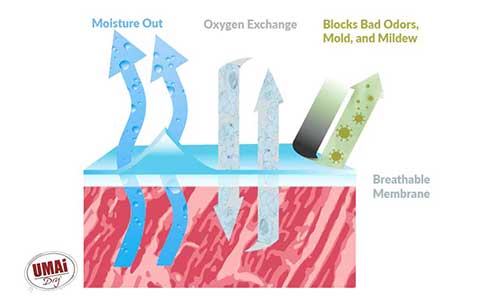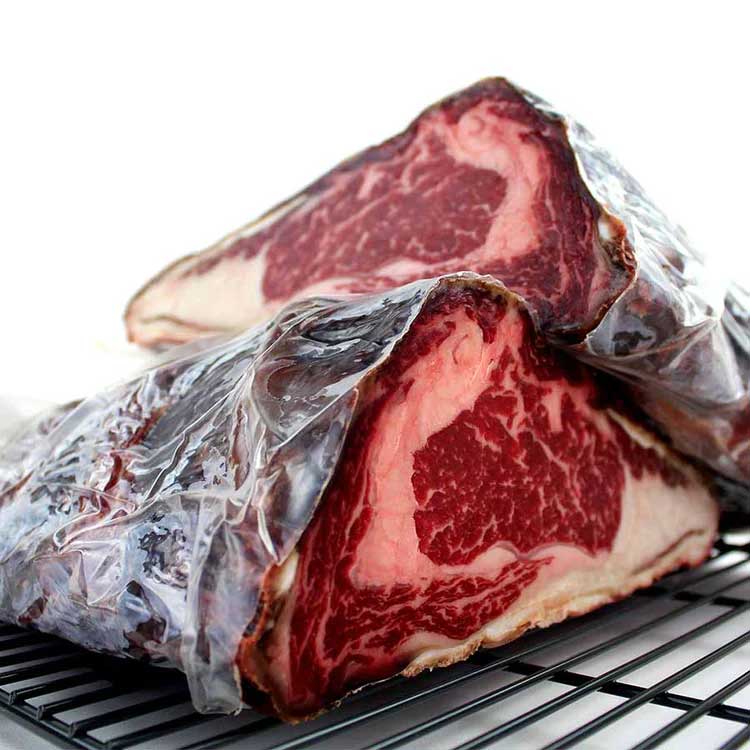The Science behind dry aging bags
Umai Dry bags have a complete and consistent bacteria barrier, all while enabling the flow of water out of the plastic foil. This allows for the highly desirable food aging and maturation of traditional meat and dairy products, but with a barrier against contamination, bacteria, and inedible mould growth. This ensures even greater food safety, and accomplishes it all without losing the proper maturation results and the special flavours of the product. All of this occurs while product yields increase, user handling is minimized, and unnecessary waste is eliminated.


Research & Studies
UMAi Dry Dry Aging Technology
-vs-
Traditional Open Air Aging


KANSAS STATE UNIVERSITY & AUBURN UNIVERSITY STUDY
Dry Aging of Beef in a Bag Highly Permeable to Water Vapour
Introduction:
“Aging beef postmortem is associated with the development of desired palatability attributes. Aging of beef typically results in increased tenderness, flavour, and overall palatability. There are two fundamental ways to age beef: wet and dry aging….”
Abstract:
The objective of this experiment was to compare traditional dry aging of beef with a novel technique of dry aging in a highly moisture-permeable bag….”
Conclusion:
Vacuum-packaged aging of beef typically implies “wet aging”. With much greater than normal moisture permeability, the vacuum-packaged bags in this study may be used to dry-age beef to increase yields, limit microbial contamination, and provide business management efficiencies without affecting product quality….
SWEDISH UNIVERSITY, CHINESE ACADEMY & KANSAS UNIVERSITY STUDY
Consumer Preference and Effect of Correct or Misleading Information After Aging Beef Longissimus Muscle Using Vacuum, Dry Aging, or a Dry Aging Bag
Abstract:
“The objective of this study was to determine which ageing treatment of beef was sensorially preferred by consumers and how their preference changed when given information about the ageing treatment used….”
Conclusions:
“In the two sensory tests in this study, dry aged and bag dry-aged beef are preferred over vacuum aged beef, and a dry-aged label positively influences a consumer’s choice of LTL….”
KANSAS STATE UNIVERSITY & AUBURN UNIVERSITY STUDY
Effects of Dry Aging of Bone-in vs. Boneless Strip Loins and Two Aging Processes for Two Different Aging Times
Introduction:
“Dry aging is an old-time process that is used to produce a high quality product marketed for high-end customers. Its most unique quality is the distinctive “dry-aged” flavor….”
Abstract:
“The purpose of this experiment was to investigate the combined effects of two dry aging methods (unpackaged and in-the-bag), two loin-cut styles (bone-in shell loins and boneless strip loins), and two aging times (21 and 28 d) on the physical, chemical, sensory, and microbial properties of dry-aged beef….”
Conclusions:
Dry aging in a bag will produce dry aged flavor equal to traditional dry aging. Dry-aged product can be vacuum stored post dry aging without major loss in palatability. Bone-in shell loins have higher yields of dry-aged product than boneless strip loins….

